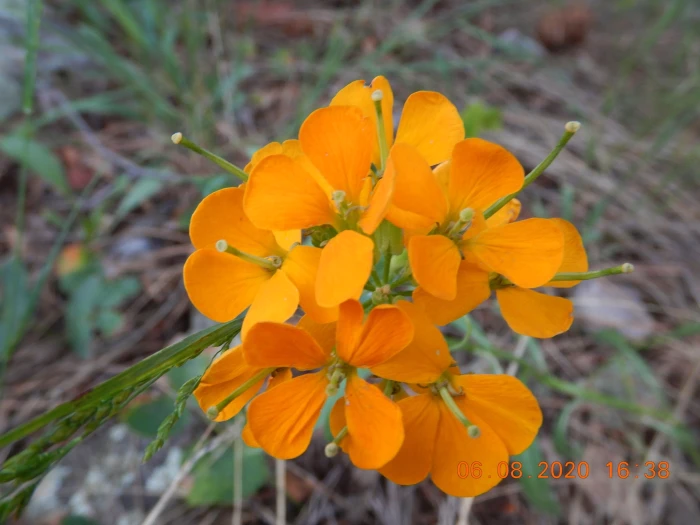Sanddune Wallflower
(Erysimum capitatum)
Sanddune Wallflower (Erysimum capitatum)
/
/

Parker Hopkins
Public Domain
Image By:
Parker Hopkins
Recorded By:
Copyright:
Public Domain
Copyright Notice:
Photo by: Parker Hopkins | License Type: Public Domain | License URL: http://creativecommons.org/publicdomain/zero/1.0/ | Rights Holder: Parker Hopkins | Publisher: iNaturalist | Date Created: 2020-06-08T16:38:15-07:00 |
























































Estimated Native Range
Climate Requirements for Dover, Delaware
| This Plant | Your Site | Plant Suitability for Your Location | ||
|---|---|---|---|---|
| • Precipitation | 3" - 119" | 45" | Aquatic | Aquatic |
| • High Temp. | 50°F - 107°F | 87°F | Your summer temperatures are normal for this plant. | Excellent |
| • Low Temp. | -29°F - 62°F | 25°F | Your winter temperatures are normal for this plant | Excellent |
This plant may not grow well at your location - your precipitation is too high.
Summary
Erysimum capitatum, commonly known as Sanddune Wallflower, is a semi-deciduous biennial or perennial herb or subshrub native to a variety of habitats including open woodlands, grasslands, and rocky slopes in the Western United States and Mexico. It typically grows to a height of 1-2 feet (0.3-0.6 meters) and a width of 0.5-1 feet (0.2-0.3 meters). The plant forms a low mound or clump with narrow, lance-shaped leaves. It produces clusters of fragrant flowers that are yellow, orange, and brown, blooming profusely in the spring, with sporadic flowering through summer and fall. The flowers are particularly showy and attract pollinators such as butterflies, making it a favorite in butterfly gardens.
Sanddune Wallflower is valued for its vibrant flowers and extended blooming period. It is often used in rock gardens, as a border plant, or in naturalized areas. This species is drought-tolerant once established and prefers full sun exposure. It thrives in well-drained soils and can tolerate a range of soil types, from sandy to loamy. While it has low to medium water requirements, it benefits from occasional watering during prolonged dry spells. Gardeners should be aware that Erysimum capitatum can self-seed and spread, which may be considered invasive in some regions. It is advisable to deadhead spent flowers to prevent unwanted spread.CC BY-SA 4.0
Sanddune Wallflower is valued for its vibrant flowers and extended blooming period. It is often used in rock gardens, as a border plant, or in naturalized areas. This species is drought-tolerant once established and prefers full sun exposure. It thrives in well-drained soils and can tolerate a range of soil types, from sandy to loamy. While it has low to medium water requirements, it benefits from occasional watering during prolonged dry spells. Gardeners should be aware that Erysimum capitatum can self-seed and spread, which may be considered invasive in some regions. It is advisable to deadhead spent flowers to prevent unwanted spread.CC BY-SA 4.0
Plant Description
- Plant Type: Herb, Subshrub
- Height: 1-2 feet
- Width: 0.5-1 feet
- Growth Rate: Rapid
- Flower Color: Yellow, Orange, Purple
- Flowering Season: Spring, Summer, Fall
- Leaf Retention: Semi-Deciduous
Growth Requirements
- Sun: Full Sun
- Water: Low, Medium
- Drainage: Slow, Medium, Fast
Common Uses
Bee Garden, Butterfly Garden, Deer Resistant, Drought Tolerant, Fragrant, Low Maintenance, Rock Garden, Showy Flowers
Natural Habitat
Native to open woodlands, grasslands, and rocky slopes in the Western United States and Mexico
Other Names
Common Names: Prarie Rocket, Coastal Wallflower, Western Wallflower, Coast Wallflower, Contra Costa Wallflower, Vélar De L’Ouest
Scientific Names: Erysimum capitatum, Erysimum capitatum var. capitatum, Erysimum capitatum subsp. capitatum, Erysimum asperum var. elatum, Erysimum macradenium, Erysimum capitatum var. angustatum, Erysimum wheeleri, Erysimum capitatum var. lompocense, Erysimum tilimii
GBIF Accepted Name: Erysimum capitatum (Douglas ex Hook.) Greene